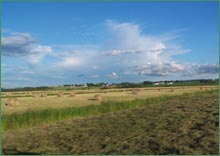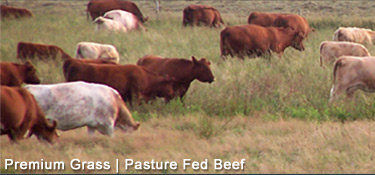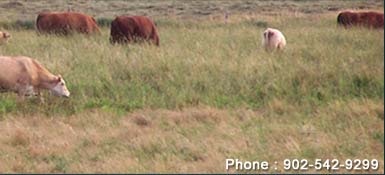| The Inuit Paradox
Conjugated Linoleic Acid (CLA)
Other Health Issues
Mad Cow Disease (BSE)
A brief primer of fat (fatty acids).
- Saturated Fatty Acids
(solid) saturated with hydrogen atoms; found in animal
products, coconut and palm oils.
- Mono-unsaturated Fatty Acids
(liquid), missing one pair
of hydrogen atoms; found in olive oil and canola oil.
- Poly-unsaturated
Fatty Acids (PUFA) (liquid); found in vegetable oils.
- Trans
Fatty Acids (solid), PUFA’s that are hydrogenated by manufacturers
in processed foods; E.Coli in grass fed beef is much less than feedlot beef.
- Omega 3, a PUFA found in fish
oils, flaxseed and wild animals including grass fed beef.
The health benefits of Omega 3.
Omega 3 in the diet causes an increase in beneficial High-density
lipo-proteins (HDL) and a decrease in deleterious Low-density
lipo-proteins(LDL) and Triglycerides. Omega 3 has been shown
to decrease the risks of sudden cardiac death, myocardial
infarction, cardiac arrythmias and stroke. It has been shown
that 1g. daily
of Omega 3 significantly reduces cardiac arrhythmia and this
effect reverses when it is withdrawn. The US Food and Drug
administration
(FDA) has recently allowed claims of decreased risk of coronary
heart disease on packaging for foods high in Omega 3 isomers.
* Omega 3 may also be beneficial in depression, osteoporosis,
colon cancer and macular degeneration. Children with Attention
Deficit Disorder have low Omega 3 levels; dopamine and serotonin
receptors
in the brain are made up of an Omega 3 isomer, and
if Omega 3 levels are low in the blood Trans Fatty Acids
may be taken up causing deformed dopamine receptors in these
children.
Omega 3 enriched rats have been shown to have better test
performances due to a significant increase in synaptic vesicles
in the brain
compared with Omega 3 deficient rats.
Only 40% of the population has an adequate consumption of
Omega 3; 20% of the population has un-detectable blood levels
of Omega 3.
| Omega 6/Omega 3 ratio |
in grass (pasture) fed beef |
2.5/1 |
| |
in grain (feedlot) beef |
14/1 |
An ideal diet has a ratio of 1-4
times more Omega 6 than Omega 3; an imbalance in this ratio
may be a significant
factor in inflammatory disorders. Grass fed beef has relatively
high Omega 3 levels, 60%
of the fatty acids in grass are Omega 3. A significant
decrease in Omega 3 levels occurs when cattle are moved
from grass pastures
onto feedlots where they are fed corn, grain and other feeds.
Grass (pasture) fed beef has total/saturated fat and Omega6/Omega
3 ratios similar to wild ruminants.
top
The Inuit Paradox
Most people are aware of the Mediterranean paradox, a diet
rich in cheese and fatty meats has a less than expected incidence
of cardiovascular disease due to the balancing effect of
fruits, vegetables, fish, olive oil and wine. The Inuit on
their traditional
diet have a cardiac death rate approximately half that of
other Canadians although they obtain greater than 50% of
their calories
from fat. However, the fat in the Inuit diet is from wild
animals such as whales, seals, caribou and fish, which have
less saturated fat,
more mono-unsaturated fat and high levels of Omega 3.
What is the fat content of grass fed beef?
Grass fed beef has less than 1/3 the fat content of grain
fed beef!
and a fat content between skinless chicken thigh
and skinless chicken breast!
| |
Mg. total fat/g. |
Cholesterol mg/i 00g. |
Omega3 mg/g.fat |
CLA |
| Grass fed Beef |
8.21 |
48.7 |
4.31 |
0.32 |
| Chicken |
7.94 |
59.3 |
1.19 |
0.07 |
The considerably lesser fat in grass fed beef results in much
lower calorie intake compared with other beef.
top
Conjugated Linoleic Acid (CLA)
CLA is a PUFA, a slightly altered form of Omega 6. CLA is
the only naturally occurring fatty acid accepted by the National
Academy of Science (USA) that exhibits consistent antitumor
products. Beef, milk and dairy products are almost the only
sources of natural CLA and Grass fed cattle have 5 to7 times
the concentration of CLA than feedlot cattle.

The beneficial effects of CLA are shown for a broad range
of experimental carcinogens. CLA may act as an anti-oxidant
scavenging
free radicals; CLA has been shown to decrease proteinase
levels, protecting basement membranes and possibly preventing
tumor
spread and metastasis; it alters more than one component
or stage of the metastatic cascade. Experimentally, there
is a
50% reduction in breast cancer induction in mice on CLA and
a 73% reduction in local tumor growth. Inhibitory effects
of CLA have been shown in vitro on cell lines of melanoma,
colo-rectal
cancer and breast cancer. Fish oil has shown a decrease in
breast cancer growth but large amounts are required in comparison
to low amounts of CLA. A study in Finland showed that
women with the highest levels of CLA had a 60% decrease in
risk of
breast cancer compared with those that had the lowest CLA
levels. CLA is present in the lean parts of beef. Cold cuts
and sausages
prepared from fatty meat may be associated with colo-rectal
cancer, but lean beef consumption may be protective. The
old studies linking red meat with colo-rectal cancer were
deeply
flawed; there may be some linkage with burnt meat but not
with rare or medium rare meat (however, it is very important
to
cook ground beef properly).
CLA has been shown to decrease body fat storage in animal
models. (An atherogenic diet with CLA
fed to mice elevated HDL and lowered triglycerides). A trial
of patients on the same diet were randomized to receive
CLA or olive oil; the CLA group showed minor decreases
in weight, body mass index and body fat and an increase in
lean body mass compared to the olive oil group. The synthetic
version of CLA taken for bodybuilding can have negative side
effects
not seen in the natural form.
top
Other Health Issues
E. coli 0157, which is a fairly virulent form of E.coli,
is present in greater than 50% of feedlot cattle. It is an
acid-resistant
bacteria resulting from the feedbot diet and may survive
human stomach acid.
Grass fed cattle are significantly cleaner than feedbot animals
with less hide contamination. E. coli in grass fed beef is
much less than 1% that of feedbot beef, in addition the E.coli
in grass fed beef is unlikely to survive the human stomach
as it is not accustomed to an acidic environment.
The feedlot diet of grain and especially corn makes an animal’s
rumen acidotic as opposed to the normal neutral state. Acidotic
animals develop rumenitis and ulcers making the rumen more
permeable and in turn causing liver abscesses. To counteract
this antibiotics are given as a matter of course, even still
11% of feedlot animals have liver abscesses compared to 0.2%
of grass fed animals that do not receive antibiotics. 70%
of all antibiotics used in the US are for animal production
(includes
chicken and hogs). Animal induced antibiotic resistance has
occurred for salmonella, campylobacter and enterococcus. More
than 50% of chickens are tainted with antibiotic resistant
bacteria.
In addition to grain, corn, straw and hay the feedlot diet
may also contain liquefied vitamins, fats, protein and hormones;
I will refrain from describing some feeding practices. No
proven risk has occurred with synthetic estrogens commonly
given in
feedlots but it is banned in Europe. Fish downstream from
these feedlots have been shown to have abnormal sex characteristics.
Grass fed beef has a four-fold vitamin E levels compared to
feedlot beef and a two-fold difference in Vitamin E supplemented
feedlot beef; one of the benefits of vitamin E is that the
meat stays fresher longer and appears redder for store freezer
appeal.
top
Mad Cow Disease (BSE)
The official scientific explanation for mad cow disease was
the feeding of ruminant animal protein to other ruminants.
The whole philosophy of natural or grass fed beef would preclude
this from occurring; grass fed beef is pastured in the growing
season and fed hay and/or silage in the winter. In addition,
Starr’s Point Steers are less than 24 months, BSE has never
been found in animals less than 24 months old.
top
| 


